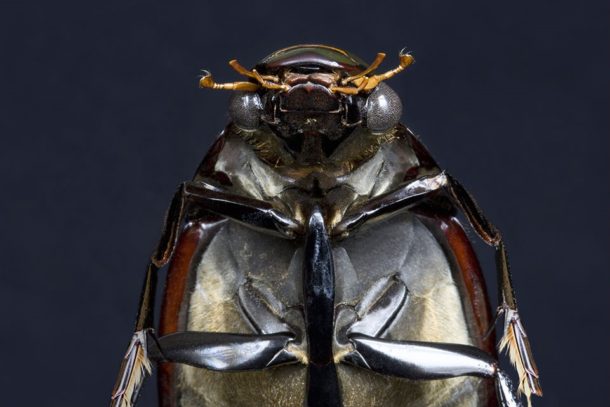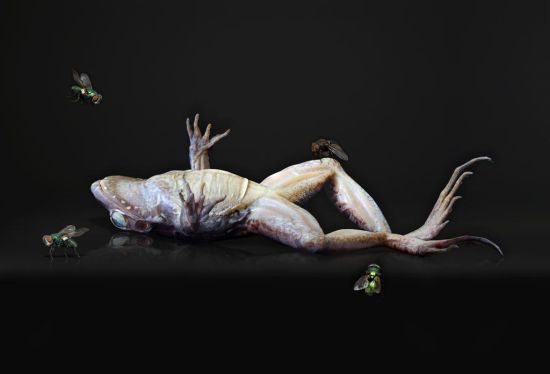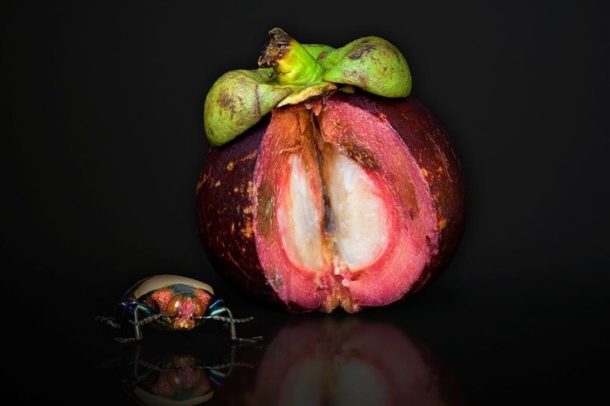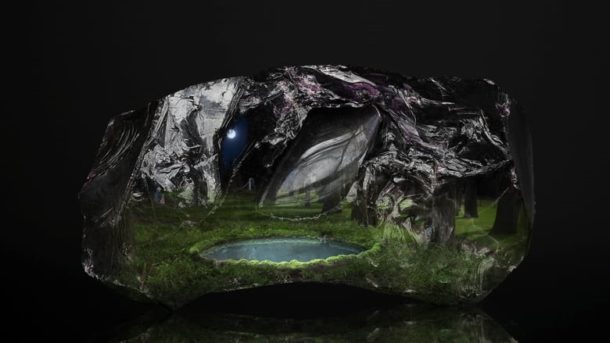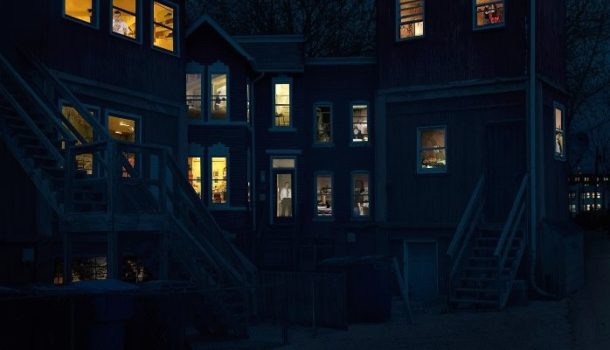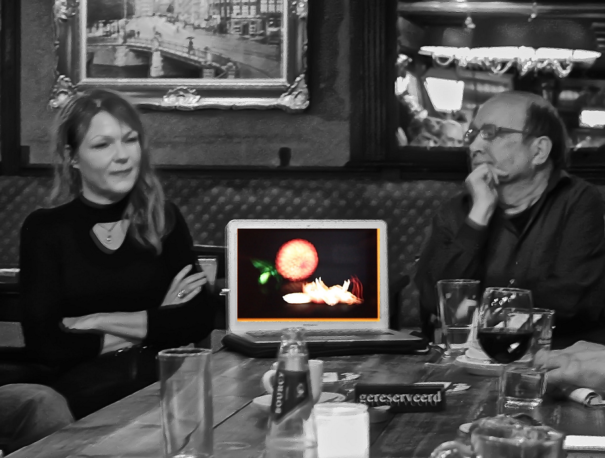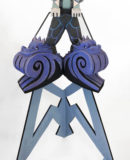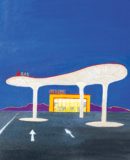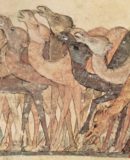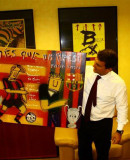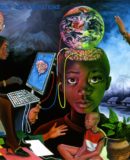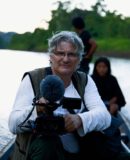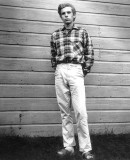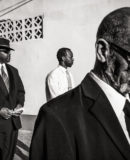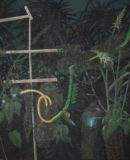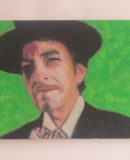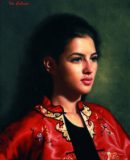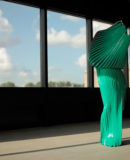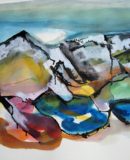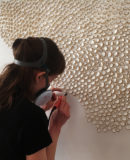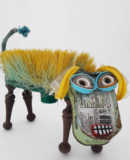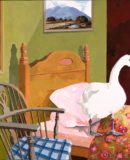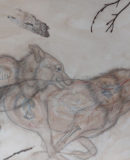World Fine Art Professionals and their Key-Pieces, 438 - Agniet Snoep
World Fine Art Professionals and their Key-Pieces, 438 – Agniet Snoep
Agniet Snoep was a guest at the 190th Photographers’ Evening in Café Kalkhoven. She creates razor-sharp images of still lifes, in keeping with the tradition of still life in the seventeenth century. She takes new steps with other objects and using contemporary techniques.
Aloys: What was your childhood like?
Snoep: “I grew up in Rotterdam. My parents thought music and reading books were important. When I was 12 I started rebelling. I became a very difficult child for my parents. I was against everything and I became punk, living in squats and wearing eccentric clothes. That was perhaps more common at that time than it is now. Between the ages of 13 and 15 I hardly went to school.”
“You would say: that doesn’t bode well, but I did have willpower. I mainly wanted to make something. I then thought about theater sets, but there was no suitable training for that at the time. That’s why I went to Fashion School. But that was not a success. I made clothes without a cut, completely shapeless, whoever wore it looked like a chimney. I made a cheesecloth suit for a friend, which fit terribly. I was looking for something that suited me better.”
“My father, A. Meijerman, was a museum director. He was in charge of three Rotterdam museums: the Schielandshuis, the Zakkendragershuisje and Dubbelde Palmboom. The red line was old art from Rotterdam. When we went on holiday in the summer we always visited museums and churches. I liked that. I still enjoy doing that with my two children, aged 15 and 16.”
“Given that family interest in culture, it was not surprising that I wanted to go to the Art Academy. In 1989 I took the entrance exam for the Rietveld Academy. I was accepted and started working on theater sets, something I always wanted. Jos Houweling was there as a teacher. We got acquainted and soon I was allowed to go to ‘Audiovisual’. Audiovisual mainly concerns sound and images. That was a bull’s eye. I had played the cello, which was an advantage, and I also always had images in my backpack. I could now use that.”
A clapper in a lampshade
Aloys: Jos Houweling was an important person for you, I understand. “He was a good teacher who helped me. At the time, many wanted to go to Audiovisual, so it was still questionable whether it would work out for me. But Jos said: ‘We don’t have Agniet yet’. He meant that he liked to have a group with different types, and a type like me wasn’t among them yet. Photography did not play a role at that time. I looked for topics. What do I want to tell the world? It is good if you can use many experiences. At one point we were in class and Houweling said: ‘Today we are going to make music without an instrument, but with everything you see’. We had chairs, cupboards and smaller objects. Some started banging their fists on the table. Others put a chair on their head and jumped with it. It was very strange. I saw lampshades at the top of the ceiling without a lamp in them. I mounted a teaspoon in the lamp and used it as a clapper, something like a sound actually came out. Jos grabbed the cupboard door and pounded it open and closed. So it became a duet.”
Video slowly came into play. “My first video was called ‘Lokken’. I had gathered 150 people in Fodor, now Foam, and wanted to film their silhouettes. I asked them to make animal sounds. I used fractions of what I had filmed and welded them together. A musical composition was created. You saw black and white images with human and animal expressions simultaneously edited at a rapid pace.”
A beetle
Aloys: was it logical for you to do something with animals? Snoep: “Many artists are working on the same things at a certain time. A friend once revealed that he liked rabbit holes. I always look at things like that, but sometimes you don’t realize something like that. I made short videos and photos of everything I could use. I will add that later, if appropriate.”
Aloys: In 1997 you came across a certain beetle in New York. “I was walking in the city and at a stand I saw an ornament of a beetle cast in resin. I knew the story ‘Metamorphosis’ by Franz Kafka. In it he describes the transformation of an ordinary man. At one point he lies in his bed and notices that he can no longer move. He looks at his legs, but they have turned into paws. He has turned into a beetle, he realizes. The man goes through all kinds of phases. He tries to live as normally as possible.
The theme of ‘beetle’ grabbed me. I started making portraits of beetles. If you make a portrait of a person and you show it to someone, they look at it with their eyes. All kinds of prejudices play a role in how the person portrayed is judged. That’s not possible with beetles, you might think, because the beetle is an alien. But you involuntarily start to think of eyes when you see a photographed beetle.” Aloys: You reinforce that in your images. Snoep: “Technically it is difficult to photograph a beetle. He is dead. It’s difficult to bring that to life. I’m suggesting that the beetle is alive. That requires very good light to make it humane.”
Tableau vivant
Agniet Snoep works with a theme. In the case of the beetles it was ‘Metamorphoses’. She started capturing beetles in still lifes. She refrained from wanting to tell a story. “I never attempt a narrative, the viewer’s brain does that.” Aloys: And then you also started recording other animals? “My mother’s name is Bosschaert from her last name. There was a story in her family, which may also be true, that the fine painter Ambrosius Bosschaert was an ancestor. He mainly painted flowers, and he took great pleasure in including some flies and insects. In the Frits Lugt Collection in Paris hangs a painting by Ambrosius Bosschaert of a dead frog lying on its back. The flies buzz around it, about to attack the corpus. The writer Bordewijk has written a story about it. As a result, I started working on a photographic tableau vivant with insects and shells. And whether you want it or not, when put together in a tableau, these objects communicate with each other.”
“It has become apparent that there must be a ‘visual rhyme’. If an object is crooked by just a millimeter, you can immediately see that it is wrong. When I place objects together, I look for kinship in materials.” She shows a photo of a tableau on her laptop. We see a flower, a crab and an open fruit, a kiwi. “It wasn’t until I looked through the lens that I saw the connection. The hairs on the objects matched. Then the image had something self-evident. Sometimes I don’t see it right away. You do it intuitively.” After making some tableaus, the still life had become a platform for her where she could express emotions such as fears and feelings. Aloys: Do you think the viewers see that too? “Maybe. But if they like the photo, that’s nice, even if they don’t see the multiple layers. But for me the first look, the aesthetics is not enough. I have completed the still lifes. That’s done.”
Catching flies
Aloys: And then? “Then I picked up a new theme. Each still life photo consists of many images. The photo of the octopus, for example, consists of 150 photos that I compressed. This makes it extremely sharp. The same with the beetles. All those photos consist of a hysterical amount of photos. Aloys: And if you try it with 20 photos? “It does not work.” How do you get your animals? Snoep: “I catch the flies myself. And my children also help me. They get a candy per fly. Artis (the Zoo) called if there was a dead frog, beetle or other insect. Recently a millipede died. I’ll take that. You have to be quick, some animals shrivel under your camera. Aloys: And afterwards, will your children bury the animals? “The edible ones go in the pan.”
A stone
“I was in America in an Indian area, where I saw a stone near a coal mine. A special stone. It was obsidian, I found out later, obsidian is black volcanic glass from rapidly solidified lava. I’m going to photograph that, I decided. I photographed the stone from three sides. On each side I have mounted a world based on the poem Paradise Lost by John Milton. Paradise Lost is about the fight between god and the devil. What is special about the book is the great attention paid to the devil’s perspective. His view, how he wants God and his creation to lose, is given a lot of space. He is defeated by God, but returns unrecognizable as a snake. He infiltrates by cunning. The scene in which Eva is tricked by the devil and therefore has to leave paradise is beautifully described.”
“In the last scene of the story, Eva steps out of paradise towards the world and says: ‘Elsewhere everything seems desolate and inhospitable, strange to us and unknown to us.’ I transferred this feeling of Eva about the world to images in the stone . These images express feelings of loss, loneliness and alienation. I have not put a hidden story in those images. I consciously leave plenty of room for the viewer’s different stories. But to get there as a viewer you have to take some time. First you have to go through two stages of seeing.”
“During the first stage of looking, attention is focused on rational matters such as who, what, when and how. The second stage of looking consists of experiencing beauty, form, color and aesthetics. Only in the third stage of viewing does the associative part of the brain kick in. It searches for a story to rationalize the feeling evoked by the images.
But that story is not there and yet there is a strong tendency to look for it. It is exactly this moment that I find interesting. A free spirit is uncontrollable. The viewer makes the memory of the stone him/herself.”
Agniet Snoep works theme-wise and she also adds something personal to all themes. “My mother died during that period. That somehow ended up in that video.” Aloys: If you had not come across that stone, your photos would have looked different. Coincidence seems to play a major role. Snoep: “Over time, a necessity arises to make certain things, these are things that are important in your life at that moment.”
Houses
Aloys: a new theme is ‘Houses’. Snoep: “Yes, the ‘Dollhouse’ project. In a live stream you see a facade with the windows behind it. You see the course of the day, from morning, evening, to night. And you see behind the windows what’s happening there. By the way, it is a different theme if you compare it with my other work. I am fascinated by what the Germans call ‘blaue Stunde’, the moment when darkness falls and you can suddenly see what is happening behind the windows. When I took the photos I cut out the windows and added a new background. I gave a major role to the imagination of the characters. It’s like you’re dreaming. But the people are not recognizable, I just need the silhouette. I can’t have people acting behind the windows.”
Agniet is in a sense obsessive and has a certain fanaticism. “I already had that at the Rietveld. For my final exam paper I made an archive of moods entitled ‘The fading of a smile’. In the Stedelijk Museum I asked 300 people to smile for the camera and then let it fade away at a certain point. If that didn’t work right away, I would say something ugly and that smile would disappear. The smile is very important in human communication, the moment that smile disappears a rug is pulled from under your feet. I thought it was important to record that.” An audience member: “It comes from the monkeys, that smiling.” Snoep: “A smile seems to give a stronger feeling of happiness than ten bars of chocolate. I edited the images in the ‘showcase organ’ with Shaun O’Neill from Mediamatic. With a pedal you could rewind and slow down those smiles. The images were recorded on Umatic, which actually no longer exists.”
Exhibitions
There are upcoming exhibitions of Agniet Snoep’s new work in two galleries: Galerie Reuten on the Prinsengracht and Cityscapes Gallery. (This interview dates from 2017.) Work is included in the Akzo Nobel collection.
Aloys: Are there other photographers or artists who inspire you? Snoep: “Laurie Anderson, she makes sound and video art. And also David Lynch.”
Are there any questions from the audience?
Do you want to start filming?
“Yes, I am very focused on film.”
Can you tell us more about how you arrive at a theme?
“A theme is taken from life, which can also be a book or film. A theme applied in the work sharpens your mind, your brain is stimulated to come up with solutions. The theme contains a certain necessity and often also a secret. It can encourage others to reveal their own secret.”
Images: 1 – 5) artworks Agniet Snoep 6) photo by Hjalmar Opdam, left Agniet Snoep, right Aloys Ginjaar
https://agnietsnoep.com/https://inzaken.eu/2023/09/27/agniet-snoep-vertelt/
Disclaimer: The views, opinions and positions expressed within this guest article are those of the author Walter van Teeffelen alone and do not represent those of the Marbella Marbella website. The accuracy, completeness and validity of any statements made within this article are not guaranteed. We accept no liability for any errors, omissions or representations. The copyright of this content belongs to Walter van Teeffelen and any liability with regards to infringement of intellectual property rights remains with the author.

